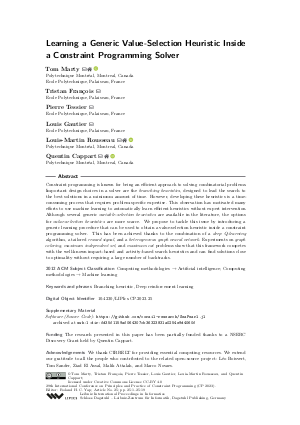@InProceedings{marty_et_al:LIPIcs.CP.2023.25,
author = {Marty, Tom and Fran\c{c}ois, Tristan and Tessier, Pierre and Gautier, Louis and Rousseau, Louis-Martin and Cappart, Quentin},
title = {{Learning a Generic Value-Selection Heuristic Inside a Constraint Programming Solver}},
booktitle = {29th International Conference on Principles and Practice of Constraint Programming (CP 2023)},
pages = {25:1--25:19},
series = {Leibniz International Proceedings in Informatics (LIPIcs)},
ISBN = {978-3-95977-300-3},
ISSN = {1868-8969},
year = {2023},
volume = {280},
editor = {Yap, Roland H. C.},
publisher = {Schloss Dagstuhl -- Leibniz-Zentrum f{\"u}r Informatik},
address = {Dagstuhl, Germany},
URL = {https://drops.dagstuhl.de/entities/document/10.4230/LIPIcs.CP.2023.25},
URN = {urn:nbn:de:0030-drops-190625},
doi = {10.4230/LIPIcs.CP.2023.25},
annote = {Keywords: Branching heuristic, Deep reinforcement learning}
}

 Creative Commons Attribution 4.0 International license
Creative Commons Attribution 4.0 International license














































